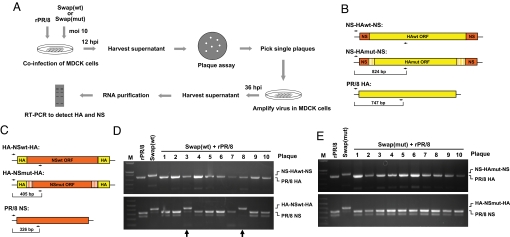Fig. 4.
The chimeric NS segment of the Swap(wt), but not of Swap(mut), virus can reassort in infected cells. (A) Diagram of the co-infection experiments. (B) RT-PCR primer design to detect the chimeric and wild-type HA segments. The RT-PCR products are 824 bp in length for the NS-HAwt-NS or NS-HAmut-NS segments and 747 bp for the wild-type HA. (C) RT-PCR primer design to detect the chimeric and wild-type NS segments. The RT-PCR products for the chimeric and wild-type NS segments are 405 and 326 bp long, respectively. (D) The Swap(wt) and rA/PR/8/34 viruses co-infection experiment. Twenty-four single plaques were characterized by RT-PCR (10 shown in the gel) using primers indicated in (B and C). The rA/PR/8/34 and Swap(wt) viruses were used for RT-PCR control (2nd and 3rd lane). M, marker. (E) The Swap(mut) and rA/PR/8/34 co-infection experiment. Forty-eight single plaques were characterized by RT-PCR (10 shown in the gel). The bands below the wild-type or chimeric NS PCR products were artificial by-products of the PCR.

